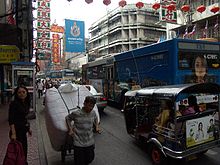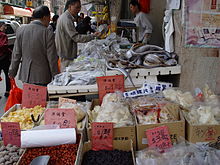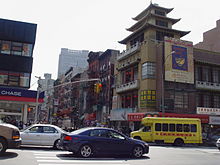Chinatown
![]()
The title of this article is ambiguous. For other meanings, see Chinatown (disambiguation).
Chinatown (Chinese 中國城 / 中国城 - "China Town, Chinese Town") refers to neighborhoods outside of China where people of Chinese descent predominantly live and work. Chinese mostly choose the term "Tangren Jie" (唐人街 - "Street of the people of the Tang era, meaning Chinese street"), regionally also "Huaren Jie" (華人街 / 华人街 - "Chinese street") or "Zhonghua Jie" (中華街 / 中华街 - "China street, Chinese street").
In the past, the term had a negative connotation because Chinatowns often had hygienic and structural problems. Chinatowns have been undergoing a process of change for some time now. The assimilation of Asian populations in many countries has led to the gentrification of formerly uniform neighborhoods. Some Chinatowns in these countries are now popular tourist destinations, especially those with long histories.
Historical development
The oldest separate Chinese neighborhoods are Shinchimachi in Nagasaki, Japan, and Yaowarat Road in Bangkok, Thailand, which Chinese merchants established more than 200 years ago. Melbourne's Chinatown was established in 1854 during the Victorian Gold Rush and is the longest continuously existing Chinatown outside of Asia.
Immigration from China to other parts of the world accelerated in the 1860s with the enactment of the Beijing Convention. The first immigrants came mainly from the coastal provinces of Guangdong and Fujian - where Cantonese, Min (e.g. Minnan language, such as Hokkien, Teochew) and Hakka are mainly spoken - in southeastern China. At first, the Qing government of China did not care about this migration of social mavericks who left the country. They were considered socially undesirable and traitors to China.
Chinese from Guangdong (Cantonese) especially from the Taishan (Taishanese) and Guangzhou (Cantonese) area first founded Chinatowns in North America (USA, Canada), Australia and Latin America (Cuba, Mexico and Peru). The American sociologist Min Zhou goes so far as to regard Western Chinatowns as a genuinely American invention. In contrast to the classic immigrant neighborhoods, for example in the view of Robert Ezra Parks, Chinatowns have not become transitional stations in the American melting pot, but rather occupy and retain a permanent economic and sociological special position.
Cantonese remained the leading language and was the heritage of many Chinatowns in the western states until the 1970s. Viewed as a group, Cantonese is linguistically and ethnically distinct from other groups in China, unlike migrants who come mainly from the Siyi and Sanyi regions (四邑三邑地區 / 四邑三邑地区), that is, the Jiangmen hinterland, such as Taishan, Heshan, Kaiping, Xinhui, where different variations of Cantonese are spoken. As a result of laws in some countries, especially the United States, where immigration of Chinese wives was not allowed due to the alleged Yellow Peril, Chinatowns developed into a place where men dominated and the male-female ratio was generally skewed. In Latin America, Cantonese-speaking migrants came to earn wages mainly as coolies. They were preferably employed in Peru in the guano fields and in Cuba on the sugar plantations, giving rise to state-supported Chinatowns.
The Hokkien and Teochew (both groups speaking the Minnan subgroup of Chinese dialects), along with the Cantonese, are the dominant groups in Southeast Asian Chinatowns such as Kuala Lumpur, Malaysia. The Hakka established Chinatowns in Africa, for example in Mauritius, in Latin America and in the Caribbean. Chinese from the North settled in Korea in the 1940s. In Europe, the first Chinese were sailors and dock workers. Because of this, the first Chinatowns there were in port cities, such as Amsterdam in the Netherlands, Hamburg in Germany, and Liverpool in the UK. France received most of the first Chinese immigrant workers, mainly from Wenzhou. Furthermore, there are also Chinatowns in Indian cities, such as Calcutta and Mumbai.
Since the mid-1970s, a process began in Chinatowns that led to substantial changes, gentrification, and tourist attraction in the affected neighborhoods. Immigrants from other parts of the Asian region moved into Chinatowns, leading to a mix of Asian ethnicities. Events such as the Vietnam War reinforced this trend. The Chinese majority population increasingly changed to a pan-Asian total population, partly losing the imprint limited to exilic Chinese.
Towards the end of the 20th century, the number of Chinatowns being founded declined sharply. Chinatowns in Las Vegas (1990) and Seoul (2005) are the most recent major foundations.
Note
1 The terms "Tángrén - 唐人" and "Huárén - 華人 / 华人" are ancient Chinese and regional terms, respectively, for people of Chinese descent versus the more modern now commonly used term "Zhōngguórén - 中國人 / 中国人 - "Chines(e)in""
2 The Chinese term "Zhōngguó chéng - 中國城 / 中国城" is a rare regional term.
3 The Japanese term "Chūka gai - 中華街" - in Chinese "Zhōnghuá jiē" - 中華街 / 中华街 - means China road or Chinese street.
4 The Japanese term "Nankin machi - 南京町" - in Chinese "Nánjīng tǐng" - 南京町 - is a local name of the Chinese quarter in Kōbe.

Chinatown in Bangkok

Business in Chinatown New York City

Chinatown in New York City
Characteristics
Historic Chinatowns with large entrance gates (paifang) built along the access roads, as well as buildings and temples in traditional Chinese architecture are considered the typical appearance of a Chinatown. Most Chinatowns are the result of chaotic development - only rarely are districts laid out in a planned manner, as in Seoul, for example. Traditionally, they achieve a high population density and are socially, culturally and to some extent economically self-sufficient from the rest of the city. Traditions such as Chinese New Year, as well as language and religions, continue unchanged. Some cities have even introduced bilingual traffic signs in Chinatowns. Asian restaurants, snack bars, shops and small industries dominate. The informal sector is an important industry.
Social conditions are fundamentally different in different cities, regions and continents. Today, increasing assimilation is causing many neighborhoods to lose their uniformly Chinese characteristics and population, and gradual gentrification is taking place. Some Chinatowns have developed into modern neighborhoods with fully developed infrastructure and strong economies. At the same time, there are many poor Chinatowns suffering from devastating deprivation. In many places, tourism has greatly improved the quality of life in the neighbourhoods. However, it also leads to the adulteration and artificial exaggeration of Asian accents.
· 
Washington, D.C.
· 
Sydney
· 
Manchester
· 
Yokohama
·
Kōbe
Questions and Answers
Q: What is Chinatown?
A: Chinatown is a neighborhood in any city outside of China where many Chinese immigrants came to live together.
Q: When did Chinatowns become common?
A: Chinatowns became common in cities around the world after China lost the first Opium War with the British Empire.
Q: Where did most of the fighting take place during this war?
A: Most of the fighting took place in Guangdong province, which was where many people became poor after China lost.
Q: Where did Chinese people move to look for work?
A: Chinese people moved to places like Malaysia, Singapore, Indonesia, and the United States to look for work.
Q: What languages are commonly spoken in Chinatowns?
A: The common languages spoken in many Chinatowns are Toishanese, Cantonese, Hakka, Teochew, and Hokkien.
Q: Which characters are used in most Chinatowns?
A: Since most Chinatowns were created before the Chinese Communist Party took over mainland China, most use traditional Chinese characters. However both simplified and traditional characters are often seen in Chinatowns in Malaysia.
Search within the encyclopedia
